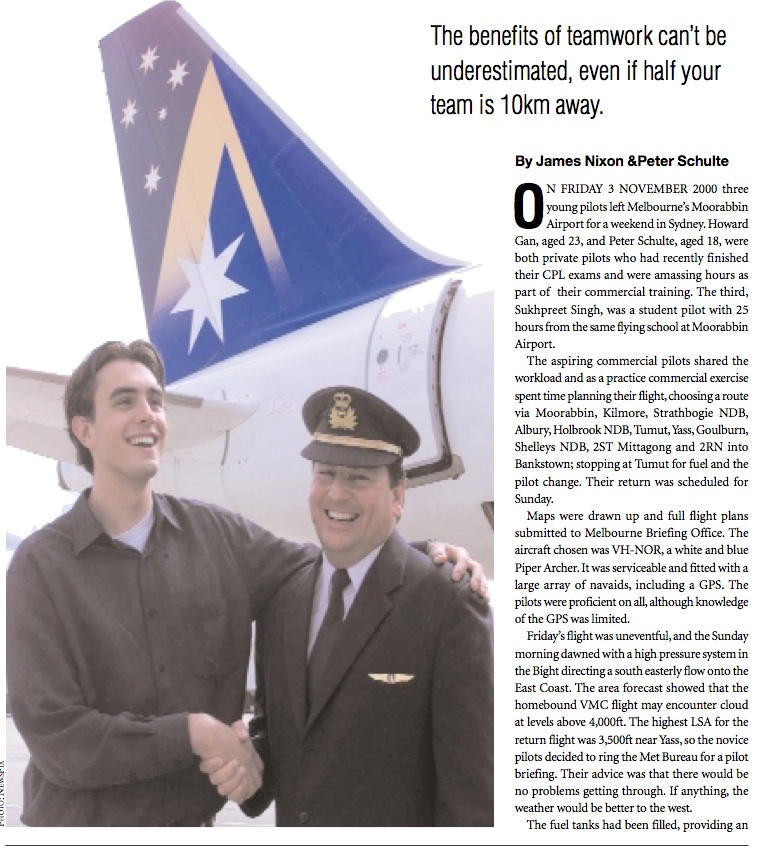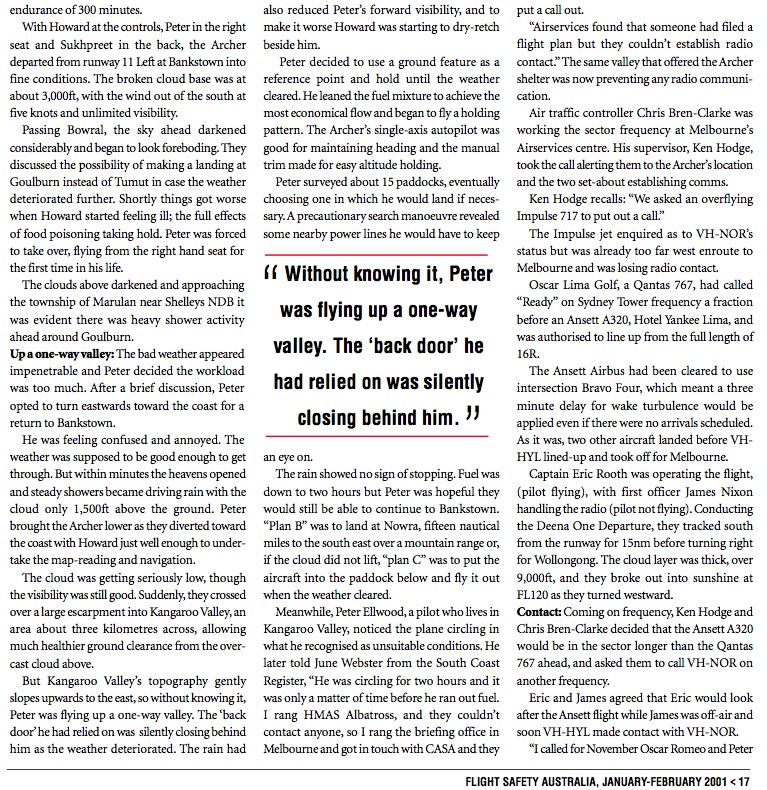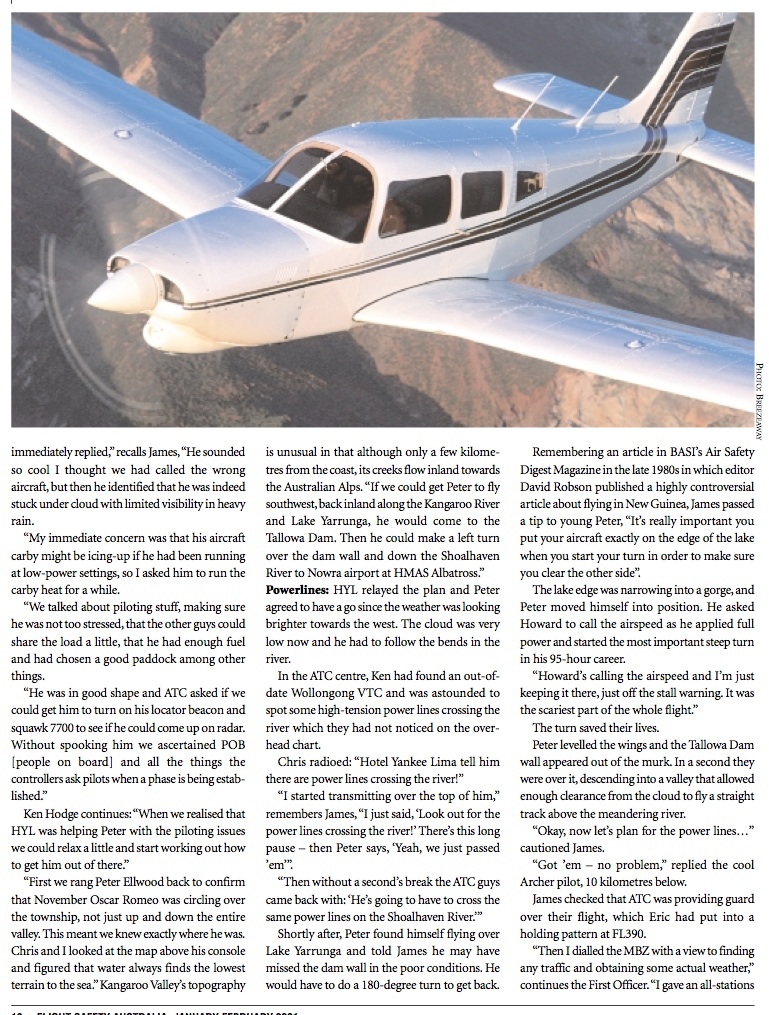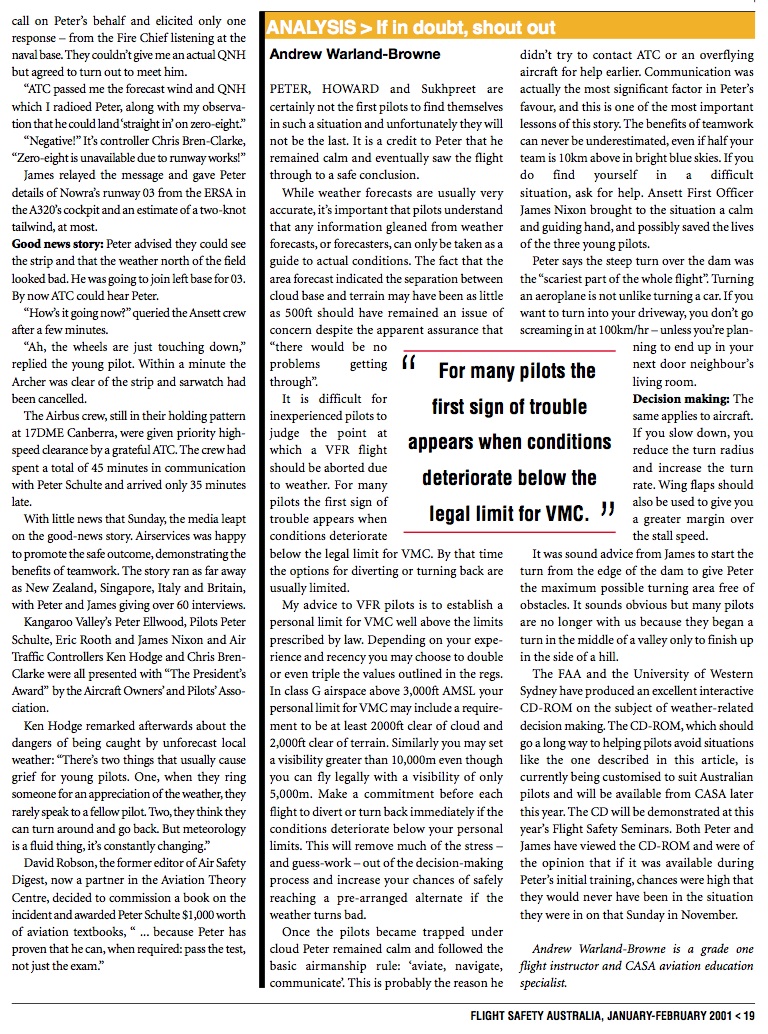jamesnixon.com
The Writer
40 years experience writing
prose and articles, publicity
and press releases,
business plans, c.vs., reports,
advertising & copy writing.
Screenplay: INTUITIVE THOUGHTS
Screenplay about Edgar Cayce,
co-written with Linda Turnbull
Book: 23 Tips To Survive
A Long Flight
A small handbook which helps passengers
survive the rigours of long haul jet travel.
Book: THE CRASH OF MH370
(Recently Retired
A380 Captain
Explores the Mystery
of the Missing Airliner)
An examination of the flight of MH370, the
Pilots and the Players in the search;
plus the conspiracy theories and
what could have happened, then what
probably happened. Concluding with 13 urgent
industry recommendations.
Book: SLEEPING FOR
PILOTS & CABIN CREW
(and other insomniacs)
The book that lifts the sheets on how to sleep whenever you want.
Investigating the twenty factors that can affect your sleep, and then
the tips and tricks you must use to sleep effectively.
Book: AND THAT'S MY SIDE
OF THE STORY
Limited edition book about an airborne
incident, an in flight engine shutdown and
diversion. As well as images, it included
the entire story from start to finish as well
as interviews with each crew-member.
Only members of the crew received copies.
Book: ON TOUR - Travels
With An Airline Pilot
19 chapters about life on the road as an
Airbus pilot for hire since leaving Australia
in March 2003, some of which have been
incorporated, along with 1450 images
(out of 33,000).
Article: SALVATION FROM ABOVE
Article about the Ansett A320 / Piper Archer incident, called the Kangaroo Valley Rescue, written for Air Safety Australia Magazine & AOPA Australia magazines, (reprinted below as a representation of style).
REAL HERO DIES
Followup article about the real hero of the Kangaroo Valley Rescue, who committed suicide only days after being jointly awarded an Air Safety Award, (also reprinted below).
SALVATION FROM ABOVE
©jamesnixon with peterschulte2001
Article reprinted from FLIGHT SAFETY AUSTRALIA MAGAZINE - February 2001




On the 3rd of November 2000 three young Pilots left Melbourne’s Moorabbin Airport for a weekend in Sydney. Two were Private Pilots who had recently finished their CPL exams and were amassing hours prior to the commencement of their commercial training. The third, a friend of theirs, was a student Pilot with 25 hours from the same flying school at Moorabbin Airport.
The aircraft chosen was November Oscar Romeo, a white and blue Piper Archer.
The aspiring Commercial Pilots would share the workload; Howard Gan, aged 23, was to fly the first leg from Moorabbin to Tumut. Peter Schulte, 18, would takeover for the Tumut to Bankstown leg.
As a practise commercial exercise the Pilots spent a fair amount of time planning their flight, choosing a route via Moorabbin, Kilmore, Strathbogie NDB, Albury, Holbrook NDB, Tumut, Yass, Goulburn, Shelleys NDB, 2ST Mittagong, and via 2RN into Bankstown; stopping at Tumut for fuel and the Pilot change.
VTC, WAC and ERC Charts were marked-up appropriately and full flight plans drawn-up. For flight notification the Pilots chose to submit a flight plan with Melbourne briefing office, nominating a Sartime for their arrival.
They elected to carry a portable locator beacon to backup the one fitted into VH-NOR. Plus the aircraft was serviceable and fitted with a large array of navaids, including a GPS. The Pilots were proficient on all, although knowledge of the GPS was limited.
The Friday flight was uneventful, save for the fact that when Peter requested Airways Clearance to enter Controlled Airspace to make a high level arrival into Sydney, the request was denied. The Pilots grumbled about the dilemma of getting experience at CTA flying if they weren’t allowed to use it.
Sunday morning dawned with a high pressure system in the Bight directing a south easterly flow onto Australia’s east coast. The area forecast showed that the homebound VMC flight may encounter cloud at levels above 4000 feet. The highest LSA for the return flight was 3500 feet near Yass, so the concerned novices decided to ring the Met bureau for a Pilot briefing from Peter’s mobile phone. The Briefing Officer gave advice that there would be no problems getting through, if anything, the weather would be better to the west.
The fuel tanks had been filled, providing an endurance of 300 minutes.
With Howard at the controls, Peter in the right seat and Sukhpreet Singh in the back the Archer departed from runway 11 Left at Bankstown into fine weather conditions. The broken cloud base was at about 3000 feet, with the wind out of the south at five knots and unlimited visibility. It was just after midday.
Passing Bowral the sky ahead darkened considerably and began looking foreboding. The plane’s occupants discussed the possibility of making a landing at Goulburn in case the weather deteriorated, instead of Tumut as had been planned.
Soon afterwards Howard started feeling ill; first just nausea and soon the full effects of food poisoning took hold. He handed over to Peter who started flying from the right hand seat for the first time in his life.
The clouds above darkened further and, approaching the township of Marulan near Shelleys NDB it was evident there was heavy shower activity ahead … in the Goulburn area.
After considering the impending bad weather, which appeared impenetrable, Peter decided the workload was getting too much and opted to turn eastwards towards the coast for a return to Bankstown.
He was feeling confused and annoyed. The weather was supposed to be good enough to get through, the Met-man had told him so. Within minutes the heavens opened and the cloud was getting lower.
Not long afterwards he noticed that Howard was looking pretty crook. They discussed the return to Bankstown. Peter had to be at work early the next day, so he could catch a Jet to Melbourne. Meanwhile Howard and Sukhpreet would wait until Howard’s food poisoning had passed, along with the foul weather, and fly home during the week.
The heavy showers became driving rain from dark heavy clouds only 1,500 feet above the ground. Peter brought the Archer lower as they diverted toward the coast. Howard, by this stage, was well enough to undertake the map-reading and navigation.
The cloud was getting seriously low, although the visibility was still good. Suddenly they crossed over a large escarpment into a huge valley, allowing much healthier ground clearance from the now overcast cloud above.
They were in Kangaroo Valley, one of those huge walled-valleys seen in the tourism commercials, about 3 kilometres across gently sloping upwards to the east. Although it was only a few kilometres from Australia’s east coast, a close inspection of the valley floor would reveal that the creeks were flowing inland towards the Australian Alps. Without knowing it, Peter Schulte was flying up a one-way valley in deteriorating weather conditions. The ‘back door’ upon which he had relied in case the weather turned bad, was silently closing behind him.
As the driving rain reduced forward visibility, with Howard nauseated and dry-retching, Peter decided to use a known ground feature as a reference point and hold until the weather cleared. At worst he could land in one of the paddocks near the hamlet that is Kangaroo Valley.
He leaned-out the engine to achieve the most economical fuel flow and commenced to fly a holding pattern. The Archer’s single axis auto pilot was good for maintaining Heading and the manual trim made for easy altitude holding.
During the holding he surveyed about fifteen paddocks, eventually choosing one in which he would land if necessary. A precautionary search manoeuvre; during which he lowered the flaps, conducted a circuit and flew low over the proposed landing area; revealed some nearby power lines. He would have to keep an eye on them.
The rain kept steadily drumming with no let-up in sight. Fuel was down to two hours remaining and, although Howard was still feeling ill, Peter was hopeful that the rain would abate and they would be able to continue coastal to Bankstown. Plan B was to land at Nowra, fifteen nautical miles to the south east over a mountain range or, if the cloud did not lift, Plan C was to put the aircraft into the paddock below and fly it out when the weather cleared.
Peter Ellwood, a Pilot who lives in Kangaroo Valley, noticed the small plane circling. He later told June Webster from the South Coast Register, “It was just such atrocious weather and usually light planes don’t fly in that type of weather.”
“He was circling for two hours and it was only a matter of time before he ran out fuel.”
“I rang HMAS Albatross, and they couldn’t contact anyone, so I rang the briefing office in Melbourne and got in touch with CASA and they put a call out.”
“They found that someone had filed a flight plan but they couldn’t establish radio contact”
Air Traffic Controller Chris Bren-Clarke was working the sector frequency at Melbourne’s Air Services centre near the base of the control tower at Melbourne Airport. His supervisor, Ken Hodge, took the call alerting them to VH-NOR’s location and the two set-about establishing coms with the Archer that, although close to an ATC antenna, was out of range due to its low altitude.
Ken Hodge recalls: “Another call came in from Nowra airport. Someone had called saying that an aircraft, November Delta Romeo, was circling at Kangaroo Valley, so we asked an overflying Impulse 717 to put out a call for November Delta Romeo.”
Peter Schulte continues “We heard them calling and said nothing. Then after a few more calls I answered ‘Are you sure you don’t mean me?’ ”
“They replied: ‘Nah, we’re after November Delta Romeo … ’ so I said, ‘We’re November Oscar Romeo, and we are stuck under some cloud in a valley…’ ”
The Impulse jet enquired as to VH-NOR’s status but was already too far west enroute to Melbourne and was losing radio contact.
_____________________________________________
Oscar Lima Golf, a Qantas 767, had called ‘Ready’ on Sydney Tower frequency a fraction before Ansett A320, Hotel Yankee Lima, and was authorised to line up from the full length of 16R. The time was 1436 local.
The Ansett Airbus had been cleared to use intersection Bravo 4 which meant a three minute delay for wake turbulence would be applied even if there were no arrivals scheduled. As it was, two other aircraft landed before VH-HYL lined-up and the takeoff roll did not commence until close to 1445.
Captain Eric Rooth was operating the flight, (Pilot Flying), with First Officer James Nixon handling the radio (Pilot Not Flying). They had begun the day at 0515 and conducted the first Melbourne - Sydney flight for the day. Repositioning to Melbourne as passengers in a 767, they flew another Airbus back to Sydney at 1030 where they waited around for two hours and forty minutes before picking up VH-HYL for flight AN951 to Melbourne at 1430.
Conducting the Deena One Departure, they tracked south from the runway for 15 nms before turning right for Wollongong. The cloud layer was thick, over 9,000 feet, and they broke out into bright sunshine at FL120 as they turned westward.
Coming on frequency, Ken Hodge and Chris Bren-Clarke decided that the Ansett A320 would be in the sector longer than the Qantas 767 ahead, and asked them to call VH-NOR on another frequency.
Eric and James agreed that Eric would look after the Ansett flight whilst James was off-air and soon VH-HYL made contact with VH-NOR.
“I called for November Oscar Romeo in the Kangaroo Valley area and Peter immediately replied. He sounded so cool I thought we had called-up the wrong aircraft, but then he identified that he was indeed stuck under cloud with limited visibility in heavy rain.”
“My immediate concern was that his aircraft carby might be icing-up if he had been running at low power settings, so I asked him to run the carby heat for a while.”
“We talked about Piloting stuff, making sure he was not too stressed, that the other guys could share the load a little, that he had enough fuel and had chosen a good paddock among other things.”
“He was in good shape and ATC asked if we could get him to turn on his locator beacon and squawk 7700 to see if he could come up on radar. Without spooking him we ascertained P.O.B. and all the things the controllers ask Pilots when a Phase is being established.”
Ken Hodge continues: “When we realised that HYL was helping Peter with the Piloting issues we could relax a little and start working out how to get him out of there. Usually you are so concerned with trying to keep the guys flying safely you don’t have time to come up with an escape plan.”
“First we rang Peter Ellwood back to confirm that November Oscar Romeo was circling over the township, not just up and down the entire valley. This meant we now knew exactly where he was, so his being lost wasn’t an issue.”
“Chris and I looked at the map above the console and figured that water always finds the lowest terrain to the sea. If we could get Peter to fly southwest, back inland along the Kangaroo River and Lake Yarrunga, he would come to the Tallowa Dam. Then he could make a left turn over the dam wall and down the Shoalhaven River to the Nowra airport at HMAS Albatross.”
HYL relayed the plan. Peter agreed to have a go since the weather was looking brighter towards the west. The cloud was very low now and Peter had to follow the bends in the river.
In the ATC centre Ken found an out of date Wollongong VTC map and was astounded to spot some high tension powerlines crossing the river which they had not noticed on the overhead chart at Chris’s console.
Chris radioed: “HYL tell him there are powerlines crossing the river!”
“I started transmitting over the top of him,” remembers James; “and can remember Eric’s eyes widening in disbelief. I just said, ‘Look out for the powerlines crossing the river!’ there’s this long pause – then Peter says, ‘Yeah, we just passed ‘em’ ”.
“For a moment I thought we had made a big mistake by encouraging him to leave the safety of the paddock he had already surveyed,” says James.
“Then without a second’s break the ATC guys came back with … ‘He’s going to have cross the same powerlines on the Shoalhaven River.’ ”
Later, Peter was flying over the lake and told James he thinks he had missed the dam wall and was told he has to do a 180 degree turn.
James remembered an article in BASI’s Air Safety Digest Magazine in the late 1980’s in which Editor David Robson published a highly controversial article about flying in New Guinea. It was about ‘Flying To Survive’ and threw the rule book out the window. He passed a tip to young Peter:
“It’s really important you put your wing exactly on the edge of the lake when you start your turn in order to make sure you clear the other side ...”
The lake edge was narrowing into a gorge. Peter placed his left wing “so close … I knew exactly where it was.” He asked Howard to call the airspeed as he applied full power and started the most important steep turn in his 95 hour career.
“Howard’s yelling the airspeed and I’m just keeping it there … just off the stall warning. It was the scariest part of the whole flight.”
The turn saved their lives.
Peter levelled the wings and the Tallowa Dam Wall appeared out of the murk. In a second they were over it, descending into a valley that fell away below and for once there was enough clearance from cloud to fly a straight track above the meandering river.
“Ok, now lets plan for the powerlines…” cautioned James.
“Got ’em – no problem” replied the cool Archer Pilot, ten kilometres below.
James checked that ATC was providing guard over their flight, which Eric had put into a holding pattern at FL390.
“Then I dialled the MBZ with a view of finding any traffic and obtaining some actual weather”, continues the First Officer. “I gave an all-stations call on Peter’s behalf and elicited only one response – from the Fire Chief listening at the Naval Base. They couldn’t give me an actual QNH, but agreed to turn-out to meet him.”
“ATC passed me the forecast wind and QNH which I radioed Peter, along with my observation that he could land straight-in on 08.”
“HYL, negative!” It was Controller Chris Bren-Clarke, ”Zero-eight is unavailable due runway works!”
Eric gives a Texan’s response as James relayed and gave him details of the Nowra’s runway 03 from the E.R.S.A. in the Ansett cockpit and passed an estimate a 2 knot tailwind, at most.
Peter advised that they could see the strip and that the weather north of the field was really bad. He was going to join left base for 03. By now ATC can hear Peter.
“How’s it going now?” queried the Ansett crew after a few minutes.
“Ah, the wheels are just touching down …” replies the young right hand seat Pilot.
James retorts: “Just keep flying - don’t worry about talking”
Within a minute the Archer was clear of the strip, sarwatch cancelled.
The Airbus crew, still in their holding pattern at 17 DME Canberra, assessed their fuel on board and decided that they had enough to make Melbourne. They were given priority high-speed clearance by a grateful ATC.
The Ansett passengers, who had previously been briefed by Captain Rooth, enquired as to the outcome so a detailed P.A. was given by the First Officer as they continued to Melbourne.
The crew had spent a total of 45 minutes in communication with Peter Schulte and arrived only 35 minutes behind schedule.
Due to the impending Melbourne Cup and USA Election there was little news on the Sunday evening and the mass media seized upon the good-news story. AirServices was happy to promote the safe outcome, demonstrating the benefits of teamwork.
The story ran for two days, as far away as New Zealand, Singapore, Italy and Britain. Peter and James gave over 60 interviews. The story was only dropped after a great white shark took the life of a Perth swimmer.
Kangaroo Valley resident Peter Ellwood, Pilots Peter Schulte, Eric Rooth and James Nixon as well as Air Traffic Controllers Ken Hodge and Chris Bren-Clarke have been awarded ‘The President’s Award’ by the Aircraft Owners and Pilots Association Of Australia.
Air Traffic Control Supervisor Hodge remarked afterwards about the dangers of being caught out by unforecast local weather: “There’s two things that usually causes grief for young Pilots. One, when they ring someone for an appreciation of the weather, they rarely speak to a fellow Pilot. Two, they think they can always turn around and go back. But Meteorology is a fluid thing, it’s constantly changing.”
David Robson, the Editor of Air Safety Digest in 1987, is now a partner in Aviation Theory Centre. He has decided to commission a book on the incident and awarded Peter Schulte $1,000 worth of aviation textbooks for the rest of his career:
“Because Peter has proven that he can, when required: Pass The Test … not just the exam. ”
©JamesNixon with PeterSchulte2000
_____________________________________________
REAL HERO DIES
©jamesnixon.com2001
(Read the background story: Salvation From Above )
The real hero of the Kangaroo Valley Rescue Team, Peter Ellwood, died by his own hand, at Strath Creek, Victoria on March 3rd, 2001 - only seventeen days after receiving a citation from the Aviation Safety Foundation Of Australia for his pivotal role in the rescue of three young Pilots in November last year.
On the day of the rescue, Peter became concerned after noticing a light plane circling over Kangaroo Valley, trapped under lowering cloud in what he described in his thick Kiwi accent as 'absolutely atrocious weather'. Concerned for the welfare of the light aircraft's occupants, he rang the flying school associated with the Nowra airport and asked if anyone was out flying.
'Nah, it's not one of ours...' said a voice before hanging-up on him. Peter persisted and rang the Navy Air Station at Nowra. Not one of theirs, either.
Most people would have stopped trying - but not Peter. He rang AirServices Australia in Melbourne and hassled everybody (it was a Sunday afternoon), until he spoke to the actual controller handling the sector.
The rest is history. The occupants of the light aircraft landed safely at Nowra after a team effort that was recognised by the Aviation Safety Foundation of Australia.
No-one will ever know for certain if Peter Ellwood saved three lives that day or not.
The steep fields which had been inundated with heavy rain for the preceding fortnight would have made the chances of survival of Peter Schulte and his two mates pretty slim – had they attempted a landing. Certainly the Piper Archer would have been damaged.
Peter Ellwood had built five aircraft himself and once had flown from New Zealand to Australia.
On that flight he had encountered low cloud and heavy rain, similar to that experienced by Peter Schulte, above the ocean east of Lord Howe Island. The weather forced him down to 700 feet above the Tasman Sea. He too had experienced the palpable fear that sometimes invades small aircraft cockpits.
A quiet man who had suffered a shocking childhood (according to his Mum), Peter had tried unsuccessfully to kill himself at least twice beforehand. This time, after a relationship breakup, he finally succeeded, a few days short of his 34th birthday.
His Mum writes: "... It seems he was truly determined to end his own life at some stage. So sad to think a lad who had achieved so much in his adult life – with still so much potential – could not handle life's knocks and felt so compelled to harm himself."
There will forever be three young men who – caught by the treachery of unforecast weather over Kangaroo Valley on a quiet Sunday afternoon – will be grateful that Peter Ellwood stuck around on this planet long enough to deliver them safely home.
His enduring quality of persistence saved their lives ... as surely as it ended his.
©jamesnixon - Easter 2001
P.S. Tragedy, in the form of his brother's suicide, would again visit Peter's mother later in the same year.
James Nixon A380 Emirates Pilot Writer Photographer Journalist Melbourne Australia jamesnixon rally On Tour Ansett Kendell 727 Albert Park camberwell canterbury carey hollingsworth rmit swinburne vietnam bahrain malta photo Airbus walkerville prom

